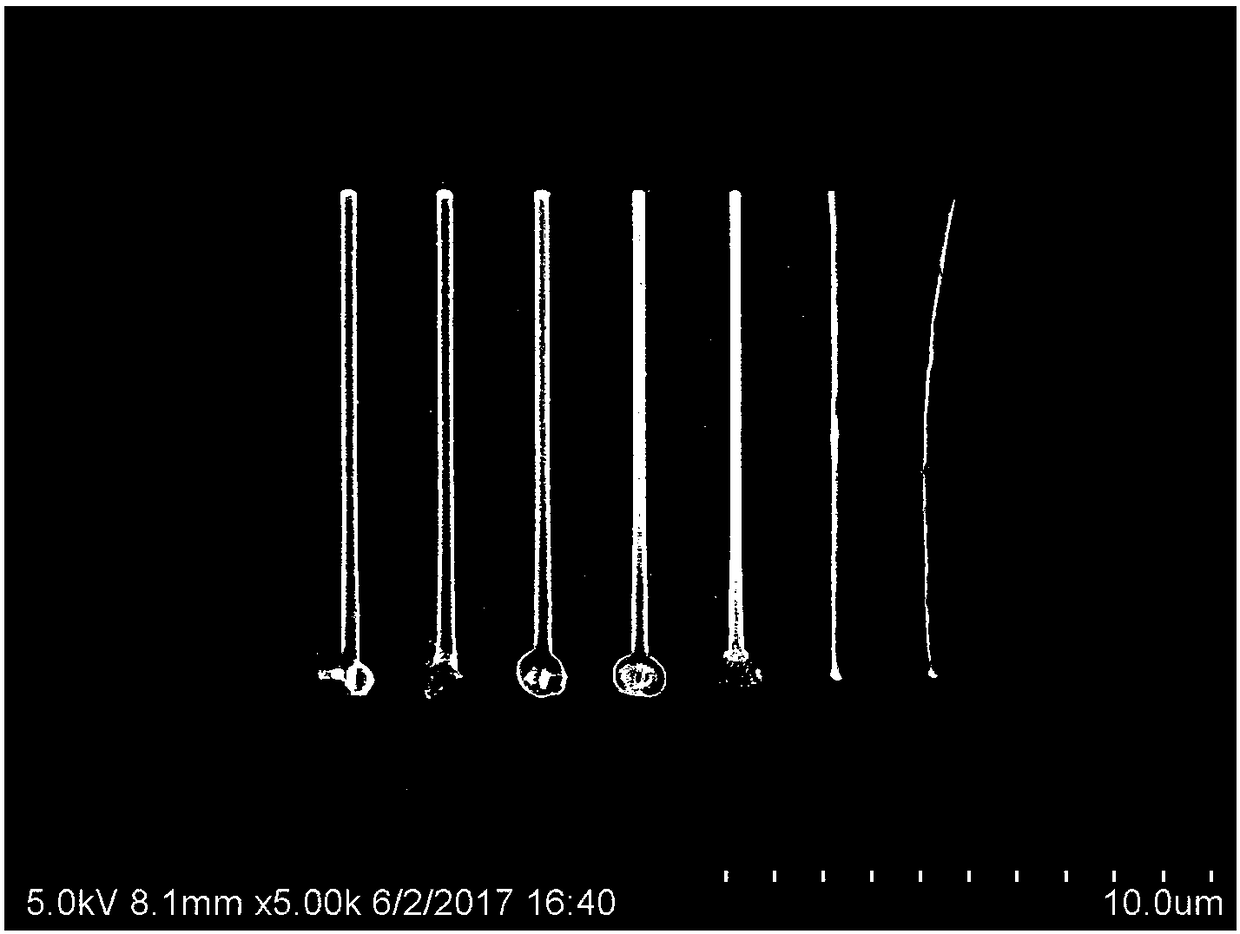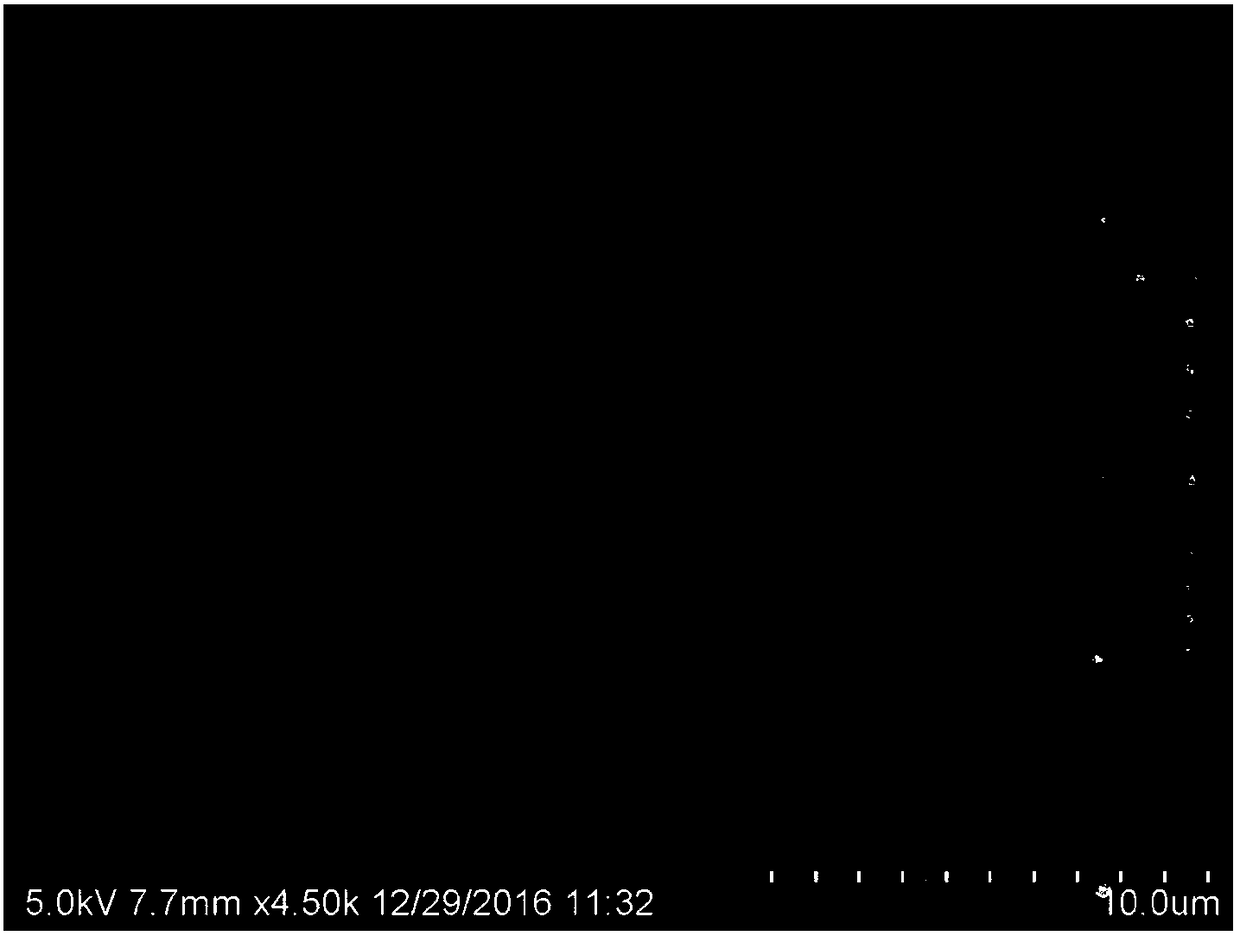Inorganic photoresist composition patterning method
A photoresist and composition technology, applied in the field of microelectronics, can solve problems such as lack of light sensitivity and limited application
- Summary
- Abstract
- Description
- Claims
- Application Information
AI Technical Summary
Problems solved by technology
Method used
Image
Examples
Embodiment 1
[0051] A method for patterning an inorganic photoresist composition, comprising the steps of:
[0052] A) Add an appropriate amount of inorganic photoresist HSQ dropwise on the glass substrate, and spin-coat at 500 rpm for 5 seconds and 4000 rpm for 60 seconds to obtain a photoresist film.
[0053] B) Bake the obtained photoresist film on a hot plate at 50° C. for 10 minutes, then raise the temperature to 100° C. and bake for 3 minutes to obtain a transparent photoresist film.
[0054] C) Utilize 780nm femtosecond laser to carry out laser direct writing exposure to this photoresist film, the line structure formed is as follows figure 1 As shown, the photoresist film after exposure was developed for 60 seconds using 0.26mol / L tetramethylammonium hydroxide (TMAH) aqueous solution, washed with deionized water and dried to obtain a photoresist pattern, from figure 1 It can be seen from the photoresist pattern shown that the photoresist pattern of the present invention has a thinn...
Embodiment 2
[0056] A method for patterning an inorganic photoresist composition, comprising the steps of:
[0057] A) Add an appropriate amount of inorganic photoresist HSQ dropwise on the silicon substrate, and spin coat at 500 rpm for 5 seconds and 4000 rpm for 60 seconds to obtain a photoresist film.
[0058] B) Bake the obtained photoresist film on a hot plate at 50° C. for 10 minutes, then raise the temperature to 100° C. and bake for 3 minutes to obtain a transparent photoresist film.
[0059] C) Utilize 780nm femtosecond laser to carry out laser direct writing exposure to this photoresist film, the line structure formed is as follows figure 2 As shown, the photoresist film after exposure was developed for 60 seconds using 0.26mol / L tetramethylammonium hydroxide (TMAH) aqueous solution, washed with deionized water and dried to obtain a photoresist pattern, from figure 2 From the photoresist pattern shown, it can be seen that the thinnest width of the photoresist pattern of the pr...
Embodiment 3
[0061] A preparation of an inorganic photoresist composition and patterning thereof, comprising the steps of:
[0062] 1) Add 0.2 mL of methyl isobutyl ketone dissolved with 15 mg of photoacid generator diphenyliodonium hexafluorophosphate into 1 mL of HSQ, and the system is protected from light to obtain a photoresist solution.
[0063] 2) The photoresist solution was filtered three times with a filter membrane with a pore size of 0.22 μm to remove impurities, and a photoresist composition P was obtained.
[0064] The prepared photoresist composition P is used for photoresist patterning, comprising the steps of:
[0065] A) Dropping an appropriate amount of photoresist composition P on the glass substrate, spin-coating at 500 rpm for 5 seconds and 4000 rpm for 60 seconds to obtain a photoresist film with good film-forming properties.
[0066] B) Bake the obtained photoresist film on a hot plate at 50° C. for 10 minutes, then raise the temperature to 100° C. and bake for 3 mi...
PUM
 Login to View More
Login to View More Abstract
Description
Claims
Application Information
 Login to View More
Login to View More - R&D
- Intellectual Property
- Life Sciences
- Materials
- Tech Scout
- Unparalleled Data Quality
- Higher Quality Content
- 60% Fewer Hallucinations
Browse by: Latest US Patents, China's latest patents, Technical Efficacy Thesaurus, Application Domain, Technology Topic, Popular Technical Reports.
© 2025 PatSnap. All rights reserved.Legal|Privacy policy|Modern Slavery Act Transparency Statement|Sitemap|About US| Contact US: help@patsnap.com



